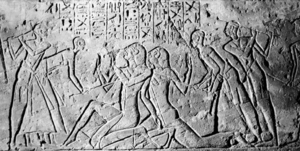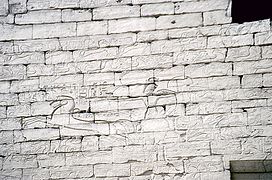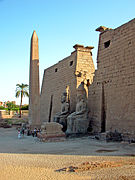Inscripciones de Qadesh

Las inscripciones de Kadesh o Qadesh son una variedad de inscripciones jeroglíficas egipcias que describen la batalla de Kadesh. La evidencia combinada en la forma de textos y relieves en las paredes proporciona la mejor documentada descripción de una batalla en toda la historia antigua. [1]
La versión egipcia de la batalla de Qadesh se registra en dos relatos principales, conocidos como el Boletín y el Poema. Estas inscripciones existen en múltiples localizaciones. Algunos eruditos dividen estas cuentas en tres. El Boletín se repite siete veces y el Poema ocho veces, repartidos en los templos de Abydos, el Templo de Luxor, Karnak, Abu Simbel y el Ramesseum, y dos papiros hieráticos.[2]
Poema
El Poema o "Poema de Pentauro" (pntAwr.t) se conoce por ocho inscripciones,[2] y enumera a los pueblos que fueron a Qadesh como aliados de los hititas. Entre ellos se encuentran algunos de los Pueblos del Mar y muchos de los otros pueblos que más tarde tomarían parte en las batallas del siglo XII a. C. (ver Batalla de Kadesh).
El Poema ha sido cuestionado como verso real, a diferencia de un relato en prosa similar a lo que habían registrado otros faraones.
Boletín
El Boletín o el Registro es en sí mismo simplemente una leyenda extensa que acompaña a los relieves.[3]
Hoy sobreviven ocho copias en los templos de Abydos, Karnak, Luxor y Abu Simbel, con relieves que representan la batalla.[2]
Otras inscripciones
Además de estas largas presentaciones, también hay numerosos pequeños subtítulos que se utilizan para señalar varios elementos de la batalla.
Fuera de las inscripciones, se conserva una copia hierática del Poema en el papiro de Raifet-Sallier, del cual se ha perdido la primera página, la segunda página ("Papyrus Raifet") está en el Louvre y la tercera página ("Papyrus Sallier III") se encuentra en el Museo Británico.[4][5] Sin embargo, esta se considera una copia imprecisa.[6]
En Hattusa se han encontrado referencias cuneiformes a la batalla, incluida una carta de Ramsés a Hattusili III escrita en respuesta a una queja burlona de Hattusili sobre la representación victoriosa de la batalla por parte del faraón.[7] Sin embargo, no se han descubierto anales que puedan describirlo como parte de una campaña. En cambio, se hacen varias referencias a él en el contexto de otros eventos.
Copias
Poema
- Pilón del Templo de Luxor, lado norte de ambas torres [8] [9]
- Karnak, fuera del muro sur de la Gran Sala Hipóstila [10]
- Abydos: templo de Ramsés II [11]
Boletín
- Abu Simbel: Pared norte del Gran Templo del primer salón [12]
- Ramesseum, lado oeste del primer pilón [13]
- Pilón del Templo de Luxor, lado sur [14]
Relieves
- Abydos: templo de Ramsés II, muros exteriores [15]
- Ramesseum, primer pilón [16]
- Ramesseum, segundo pilón [17]
- Karnak [18]
- Pilón del Templo de Luxor : [19]
- Templo de Derr [20]
- Abu Simbel: Pared norte del Gran Templo de la primera sala [21]
Galería
- Abydos
- Luxor
- Karnak
- Ramesseum
- Abu Simbel
Ver también
Referencias
- ↑ Ockinga, 1987, p. 38. : "No battle fought in antiquity is so well-documented as the clash between the Egyptians and the Hittites before the city of Kadesh on the Orontes in 1275 BC"
- ↑ a b c Lichtheim, 1973, p. 57: "Subsequently the campaign was told al length in two separate accounts which scholars have called the Bulletin (or the Record) and the Poem. The two accounts are supplemented by pictorial reliefs with explanatory captions. The whole composition offers a number of striking features. First the fact that there are two distinct though overlapping accounts. Second the fact that the two versions were not merely carved once on the walls of a temple but were repeated in multiple copies – the Bulletin seven times and the Poem eight times. They are inscribed on the walls of the temples of Abydos, Luxor, Karnak, Abu Simbel and the Ramesseum, and the Poem is also found on fragments of two hieratic papyri.
- ↑ Gardiner, Alan, The Kadesh Inscriptions of Ramesses II (1975) pp. 2–4. However, Miriam Lichtheim, Ancient Egyptian Literature, Vol. 2: The New Kingdom (1978) p. 58, maintains that the Poem is truly just that, contra Gardiner, and prefers to maintain the older tripartite division of the documentation.
- ↑ Transactions: The Third Sallier Papyrus. 1874. p. 84.
- ↑ Breasted, James Henry, Ancient Records of Egypt: Historical Documents (1906) p. 58.
- ↑ Gardiner, p. 2
- ↑ Kitchen, Kenneth A., Ramesside Inscriptions, Notes and Comments Volume II (1999) pp. 13ff.
- ↑ Breasted, 1903, p. 84, n.19.1. : "The Luxor copy occupies the lower portion of the front (north side) of both towers of Ramses II's pylon... The inscription was partially cleared by Mariette, which permitted E. de Rouge to copy [most of it]"
- ↑ Breasted, 1903, p. 84 n.20. : "All these texts, including the hieroglyphic, were once combined by E. de Rouge and published after his death by J. de Rouge (Rev. e.g., III–IX) [in 1883]."
- ↑ Breasted, 1903, p. 84, n.19.2. : "The Karnak copy is on the outside of the south wall of the great hypostyle hall. "
- ↑ Breasted, 1903, p. 84, n.19.3. : "The Abydos copy on the walls of Ramses II's mortuary temple there has preserved only the lower ends of the lines, as the walls are destroyed except the last few courses."
- ↑ Breasted, 1903, p. 85, n.21.1. : "Abu Simbel – In the great rock temple on the north wall of the first hall over the battle reliefs. It was published by Champollion (Mon., 27–9), by Rossellini (Mon. stor., 100–102), and by Lepsius (LD., Ill, l87c–e). The original itself is very careless, the scribe having omitted the lower two-thirds of 1. 7 and beginning of 1. 8 (Ramesseum numbering)."
- ↑ Breasted, 1903, p. 85, n.21.2. : "Ramesseum – Over the battle reliefs on the rear (west) side of the first pylon. It was published by Sharpe (Eg. Inscr. 2d part 52), and by Lepsius (LD., III, 153). It is the best of all the texts, though Lepsius's copy needs some correction."
- ↑ Breasted, 1903, p. 85, n.21.3. : "3. Luxor. – On the rear (south side) of Ramses II's pylon... But these modern buildings of the natives have never been removed, and we have only a copy of the visible fragments by Brugsch (Rec. de mon., II, 53)"
- ↑ Breasted, 1903, p. 86, n.22.1. : "Abydos. – On the outside of the north, west, and south walls of the temple of Ramses II. Nearly the whole has perished, as only the lower courses of the walls remain. The short inscriptions were published by Mariette (Abydos II, pp. 10–11)"
- ↑ Breasted, 1903, p. 86, n.22.2. : "Ramesseum, First Pylon. – Champ., Not. Descr., I, 870–72"
- ↑ Breasted, 1903, p. 86, n.22.3. : "Ramesseum, Second Pylon. – Champ., Mon., 328–30; Not. Descry. 585–89, 873, 874"
- ↑ Breasted, 1903, p. 86, n.22.4. : "Karnak. – Chiseled out in antiquity; published infra, pp. 45, 46, and Plate VIII."
- ↑ Breasted, 1903, p. 86, n.22.5. : "Luxor – On pylon of Ramses II.; Champ., Mon., 323, 324, 327–327 (last two incorrectly marked Ramesseum)"
- ↑ Breasted, 1903, p. 86, n.22.6. : "Derr – Now destroyed, but seen by Champollion, Weidemann, Aeg. Gesch., 434, n. 5"
- ↑ Breasted, 1903, p. 86, n.22.7. : "Abu Simbel – In the great temple, first hall, north wall; Champ Mon., 17 bis-33; Not. Descr., I, 64–66"
Bibliografía
- Breasted, James Henry (1903). The battle of Kadesh : a study in the earliest known military strategy.
- Ockinga, Boyo (1987), «On the Interpretation of the Kadesh Record», Chronique d'Égypte 62 (123–124): 38-48, doi:10.1484/J.CDE.2.308740.
- Gardiner, AH 1960. Las inscripciones de Kadesh de Ramsés II . Oxford
- Thomas Charles Hartman (1967). The Kadesh Inscriptions of Ramesses II: An Analysis of the Verbal Patterns of a Ramesside Royal Inscription. Brandeis University.
- Anthony John Spalinger (2002). The Transformation of an Ancient Egyptian Narrative: P. Sallier III and the Battle of Kadesh. Otto Harrassowitz Verlag. ISBN 978-3-447-04355-7.Anthony John Spalinger (2002). The Transformation of an Ancient Egyptian Narrative: P. Sallier III and the Battle of Kadesh. Otto Harrassowitz Verlag. ISBN 978-3-447-04355-7. Anthony John Spalinger (2002). The Transformation of an Ancient Egyptian Narrative: P. Sallier III and the Battle of Kadesh. Otto Harrassowitz Verlag. ISBN 978-3-447-04355-7.
- Lichtheim, Miriam (1973). «The Kadesh Battle Inscriptions of Ramses II». Ancient Egyptian Literature: The late period. University of California Press. pp. 57-. ISBN 978-0-520-03615-4.Lichtheim, Miriam (1973). «The Kadesh Battle Inscriptions of Ramses II». Ancient Egyptian Literature: The late period. University of California Press. pp. 57-. ISBN 978-0-520-03615-4. Lichtheim, Miriam (1973). «The Kadesh Battle Inscriptions of Ramses II». Ancient Egyptian Literature: The late period. University of California Press. pp. 57-. ISBN 978-0-520-03615-4.










